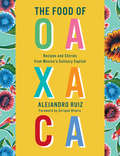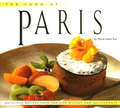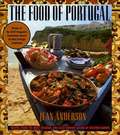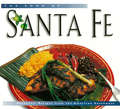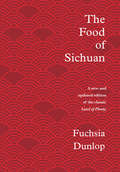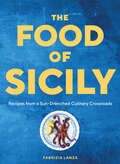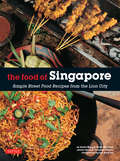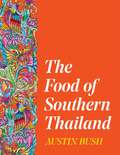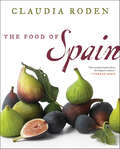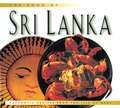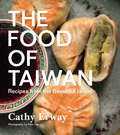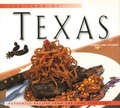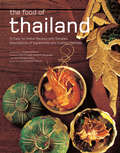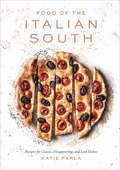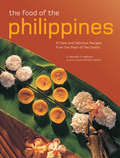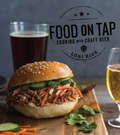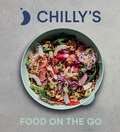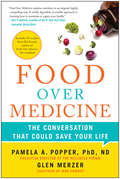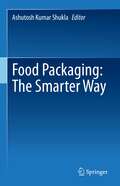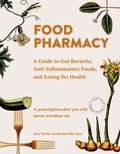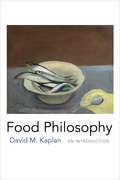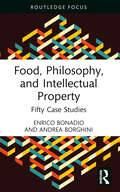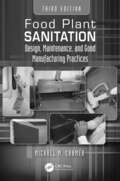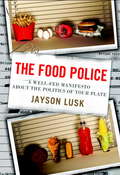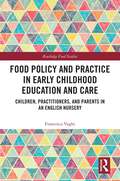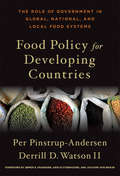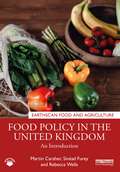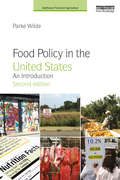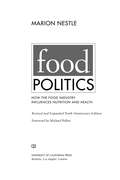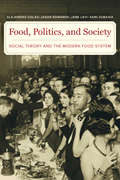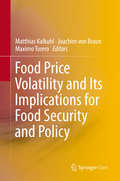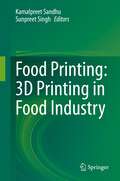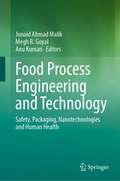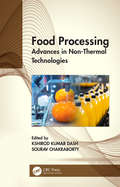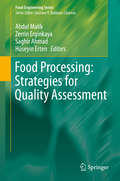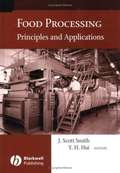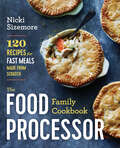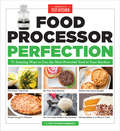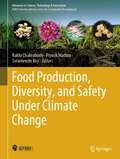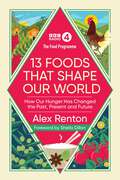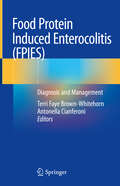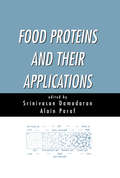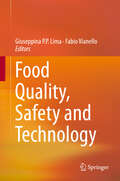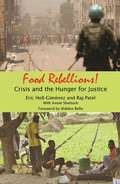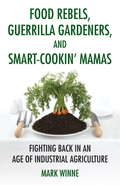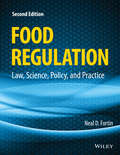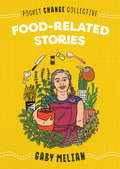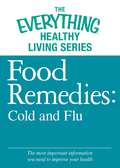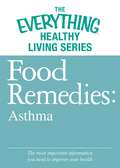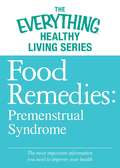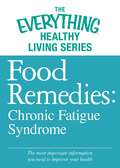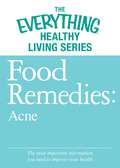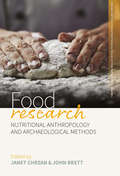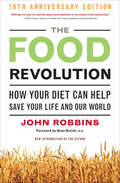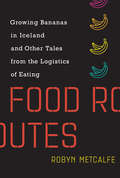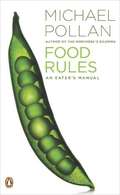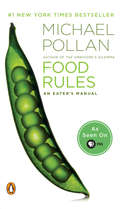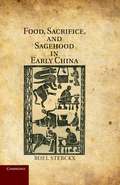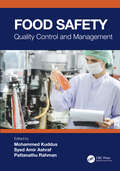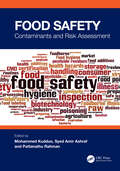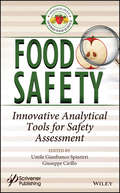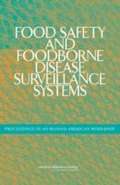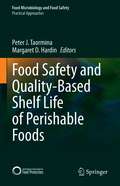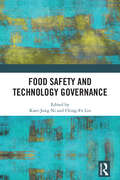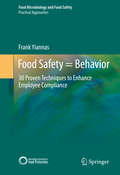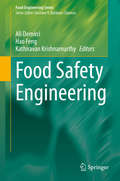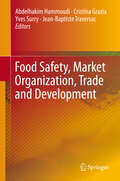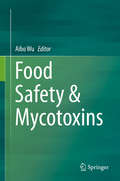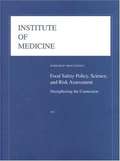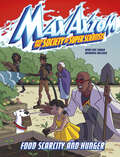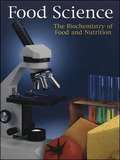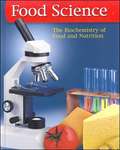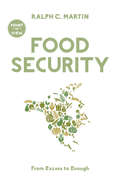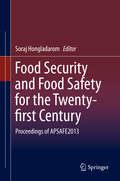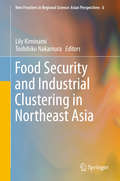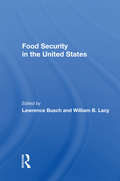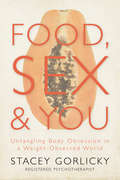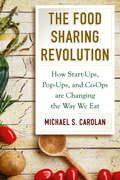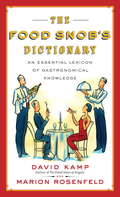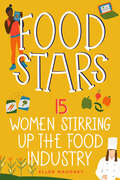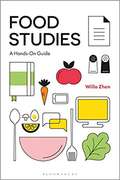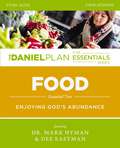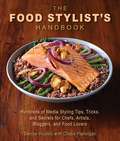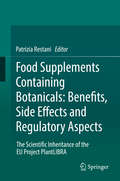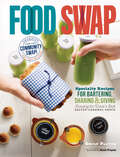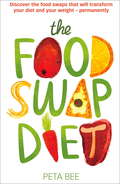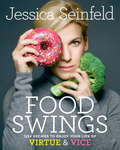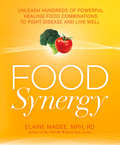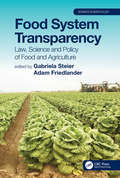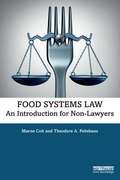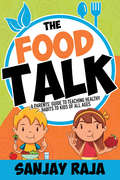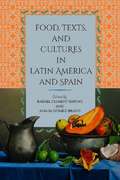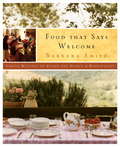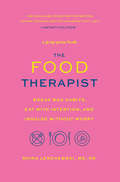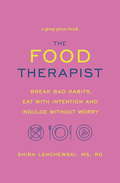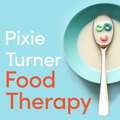- Table View
- List View
The Food of Oaxaca: Recipes and Stories from Mexico's Culinary Capital
by Alejandro Ruiz Carla AltesorA groundbreaking cookbook celebrating the distinctive cuisine and culture of Oaxaca, from one of Mexico's most revered chefs. With a foreword by Enrique Olvera.In The Food of Oaxaca, acclaimed chef Alejandro Ruiz shares the cuisine of Mexico&’s culinary capital through fifty recipes both traditional and original. Divided into three parts, the book covers the classic dishes of the region, the cuisine of the coast, and the food Ruiz serves today at his beloved restaurant, Casa Oaxaca. Here are recipes for making your own tortillas, and for preparing tamales, salsas, and moles, as well as Ruiz&’s own creations, such as Duck Tacos with Coloradito; Shrimp, Nopal, Fava Bean, and Pea Soup; and Oaxacan Chocolate Mousse. Also included are thoughtful essays on dishes, ingredients, kitchen tools, and traditions; recommendations on where to eat; and a comprehensive glossary to help fully immerse readers in the food of Oaxaca, making this an indispensable volume for home cooks and travelers alike.
The Food of Paris
by Marie-Noel Rio Jean Francois HamonParis - the "City of Lights" with its magnificent tradition of architecture, fashion, literature, and art is also known throughout the world as the gourmet capital of France.The Food of Paris features over 60 delicious recipes gathered from a broad spectrum of celebrated Parisian eateries. Savor such mouthwatering dishes as Onion Soup, Pumpkin Tart with Apples and Nuts, Sole Meuniere with Steamed Potatoes, Orange Butter Tuna Steaks, Salmon and Ham Tournedos, Roast Duck, Guinea Fowl Confit, Steak Tartare, Fillet of Beef with Potato Gratin, and Crepes Suzette with Grand Marnier.Dramatic location photography, coupled with detailed information on ingredients, as well as fascinating insights into the culture of this much loved city, make The Food of Paris the perfect companion for your adventure into the cuisine of this city of gourmands.
The Food Of Portugal
by Jean AndersonAn extensive bilingual glossary explains, defines, and describes Portuguese food, wine, cooking, and restaurant terms. With notes for cooks and travelers on the language of Portuguese wine, food, and dining. Wine notes have been completely revised and updated. Color photographs of Portugal by the author.
The Food of Santa Fe: Authentic Recipes from the American Southwest
by Dave Dewitt Nancy GerlachThese beautiful books offer complete information on ingredients, utensils, and cooking techniques. Each volume presents the best authentic recipes and detailed explorations of the cultural context in which dishes are created and enjoyed. Each title contains 70 to 90 beautiful full-color photographs and a range of mouth-watering recipes by some of the area's best chefs. Copyright © Libri GmbH. All rights reserved.
The Food of Sichuan
by Fuchsia DunlopNamed one of the most anticipated cookbooks of Fall 2019 by Bon Appétit, Eater, Epicurious, and Literary Hub. An essential update of Fuchsia Dunlop’s landmark book on Sichuan cuisine, with 200 recipes and stunning photographs. Almost twenty years after the publication of Land of Plenty, considered by many to be one of the greatest cookbooks of all time, Fuchsia Dunlop revisits the region where her own culinary journey began, adding more than 70 new recipes to the original repertoire and accompanying them with mouthwatering descriptions of the dazzling flavors and textures of Sichuanese cooking. Food of Sichuan shows home cooks how to re- create classics such as Mapo Tofu, Twice-Cooked Pork and Gong Bao Chicken, or a traditional spread of cold dishes, including Bang Bang Chicken, Numbing-and-Hot Dried Beef, Spiced Cucumber Salad and Green Beans in Ginger Sauce. With gorgeous food and travel photography and enhanced by a culinary and cultural history of the region, The Food of Sichuan is a captivating insight into one of the world’s greatest cuisines.
The Food of Sicily: Recipes from a Sun-Drenched Culinary Crossroads
by Fabrizia LanzaIn this all-new cookbook from Fabrizia Lanza, one of the world&’s greatest food cultures is distilled in 75 recipes for the home cook, plus a loving tribute to its ingredients, passions, influences, and history Tucked away on an estate in the countryside south of Palermo is the Anna Tasca Lanza Cooking School, a unique center dedicated to preserving and sharing the great food culture of Sicily. The spirit of the school, now run by Fabrizia Lanza, the founder&’s daughter and scion of a renowned family of winemakers that goes back generations, is what makes Lanza&’s The Food of Sicily such a singular cookbook—not just a collection of recipes and techniques, but a vibrant and beautifully photographed profile of the land, the people, the history, and so much more. On every page, in every recipe and note, the author captures the distinct taste of Sicily. How the simplest antipasti, brightly seasoned with nothing but lemon or vinegar, open the appetite—like a classic Octopus Salad or dish of Sautéed Black Olives. The little fried somethings—like an arancine or panelle—are easy, welcome, and nourishing. The Fresh Cavatelli, Pasta with Eggplant and Tomatoes, Bucatini with Sardines and Wild Fennel, and the eye-opening Anelletti Timballo explain why Sicilians are the biggest pasta eaters in the world. Festive meat dishes—such as Lamb-Stuffed Pastry, an Easter staple, or Grilled Sausage with Bay Leaves and Onions—are festive because the moment it&’s holiday time, Sicilians everywhere head outside and fire up their grills. And for a people known for their passion for sweets, some famous Sicilian treats—Watermelon Pudding, Lemon Granita, Rolled Fig Cookies, and the pinnacle of desserts, the elaborate Sicilian Cake with Ricotta Cream and Marzipan. Along the way, the author delves into everything from cheese, couscous, and olives to Amaro and the importance of bitterness. Visitors to Sicily often sense it to be a place unlike anywhere else—lost in time and a little bit secretive. The Food of Sicily opens a bright window on it, celebrating this wonderful food culture while honoring everything that makes it special.
Food of Singapore
by David Wong Djoko WibisonoThe native cuisines of this diverse society have evolved into a unique and exciting blend, brought to you in this collection of strikingly illustrated dishes. You will also be introduced to the nation's dynamic cultural and culinary traditions. The Food of Singapore presents over 60 easy-to-follow recipes, with descriptions of ingredients and cooking methods, enabling you to reproduce the distinctive flavors of Singapore in your very own kitchen.
The Food of Southern Thailand
by Austin BushA beautiful, eye-opening guide to the culture and cuisine of Thailand’s south, featuring the region’s quintessential recipes: spicy noodles, coconut curries, and seafood dishes. Austin Bush has spent decades traveling across Thailand, collecting recipes, observing cooking techniques, taking photographs, and recording stories. With his documentarian’s eye, he captures the rich culinary traditions of the country’s southern region, making this the first cookbook in English to focus on the cuisine. The Food of Southern Thailand continues Austin’s ambitious project of illuminating Thailand’s foodways. Shared here are bold, spicy flavors of chile, turmeric, and black pepper that link countryside and island. Gathered, too, are cosmopolitan dishes from the cities that blend ingredients such as coconut milk and fish sauce. The food of southern Thailand is like nothing you’ve encountered before: vibrant, thanks to Thailand’s colorful larder; diverse, reflecting various waves of immigration to the region; and delicious beyond what you might find in most restaurants in the United States. In lush photographs and helpful step-by-step illustrations, Austin explores, bite by bite, the mouthwatering offerings of roadside stalls and tiny island restaurants. His detailed recipes feature the region’s most beloved dishes, including a variation on a classic tart, spicy soup with vegetables and fish, Hat Yai–Style Fried Chicken with Sticky Rice (served with a tangy dipping sauce), and Minced Kingfish Stir-Fried in a Spicy Herb Paste. Sweets from the region are unique, often wrapped in banana leaves and filled or dusted with local palm sugar: fragrant cashew brittle, crispy fritters, warm coconut pancakes. A dream book for armchair travelers, intrepid cooks, and those eager to explore the backroads of a beautiful country, The Food of Southern Thailand is a crucial record of a cuisine as it is lived now. Austin’s vivid writing and careful reporting will transport all with a powerful story of a place and its people and bring one-of-a-kind dishes to life in your home kitchen.
The Food of Spain
by Claudia RodenOne of our foremost authorities on Mediterranean, North African, and Italian cooking, Claudia Roden brings her incomparable authenticity, vision, and immense knowledge to bear in The Food of Spain. The James Beard Award–winning author of the classic cookbooks A Book of Middle Eastern Food and A Book of Jewish Food now graces food lovers with the definitive cookbook on the Spanish cuisine, illustrated with dozens of gorgeous full-color photographs that capture the color and essence of this wonderfully vibrant nation and its diverse people, traditions, and culture.
Food of Sri Lanka
by Wendy Hutton Douglas BullisThis book features over 60 sumptuous recipes originating from the four corners of the island, including classics such as appa and iddiappan (eff and string hoppers), pittu (steamed rice flour rolls), kiri bath (milk rice), ambulthiyal (claypot fish), konda kaum (topknot cakes) and an array of sambol or condiments. Stunning location photography, a detailed glossary of ingredients, and comprehensive introduction to this paradise isle, make The Food of Sri Lanka the perfect companion for your adventure into the delicious world of Sri Lankan cuisine.
The Food of Taiwan: Recipes from the Beautiful Island
by Cathy ErwayThe acclaimed food writer offers an insider's look at Taiwanese cooking from home-style dishes to authentic street food in &“this appetizing collection&” (Publisher Weekly, starred review). While certain dishes from Taiwan are immensely popular, like steamed buns and bubble tea, much of the cuisine still remains relatively unknown in America. In The Food of Taiwan, Taiwanese-American Cathy Erway, the acclaimed blogger and author of The Art of Eating In, explores the rich culture, history, and culinary traditions of Taiwan—including nearly 100 recipes. Recipes range from familiar dishes, such as Pork Belly Buns, Three Cup Chicken, and Beef Noodle Soup, to more uncommon fare, like the Stuffed Bitter Melon, Oyster Noodle Soup, and Dried Radish Omelet. Tantalizing food photographs intersperse with beautiful shots of Taiwan&’s coasts, mountains, and farms as well as images of bustling city scenes, making this book just as enticing to flip through as it is to cook from.
Food of Texas
by Caroline Stuart Jacob TermansenThe Food of Texas presents the authentic flavors of Texas in all its southern glory with over ninety brilliant photos and over seventy recipes. An extensive introduction by author Caroline Stuart and Dotty Griffith, dining editor and restaurant critic for The Dallas Morning News describes the culture, history, and lore that define Texan cuisine. Cooking tips and a glossary of ingredients make it easy to wrangle authentic, delicious Lone Star staples.
Food of Thailand
by Sven Krauss Laurent Ganguillet Vira Sanguanwong Luca Invernizzi TettoniThai cuisine is unique, having drawn inspiration form such diverse sources as China and India, Persia and Portugal. <P><P>This book presents a cross-section of Thai recipes from all regions of the country-as prepared in private homes, street stalls and even palace kitchens.Produced and photographed entirely in Thailand, this book offers an in-depth look at the unique cultural origins and influences behind Thai cuisine, and provides recipes for universal favorites such as Tom Yang Goong and Pad Thai, as well as numerous sauces, dips, salads, snacks and desserts.
Food of the Italian South: Recipes for Classic, Disappearing, and Lost Dishes
by Katie Parla85 authentic recipes and 100 stunning photographs that capture the cultural and cooking traditions of the Italian South, from the mountains to the coast.In most cultures, exploring food means exploring history—and the Italian south has plenty of both to offer. The pasta-heavy, tomato-forward “Italian food” the world knows and loves does not actually represent the entire country; rather, these beloved and widespread culinary traditions hail from the regional cuisines of the south. Acclaimed author and food journalist Katie Parla takes you on a tour through these vibrant destinations so you can sink your teeth into the secrets of their rustic, romantic dishes. Parla shares rich recipes, both original and reimagined, along with historical and cultural insights that encapsulate the miles of rugged beaches, sheep-dotted mountains, meditatively quiet towns, and, most important, culinary traditions unique to this precious piece of Italy. With just a bite of the Involtini alla Piazzetta from farm-rich Campania, a taste of Giurgiulena from the sugar-happy kitchens of Calabria, a forkful of ’U Pan’ Cuott’ from mountainous Basilicata, a morsel of Focaccia from coastal Puglia, or a mouthful of Pizz e Foje from quaint Molise, you’ll discover what makes the food of the Italian south unique.
Food on Tap: Cooking With Craft Beer
by Lori RiceDiscover new ways to savor your favorite beer with 60 traditional and inventive recipes. In the age of craft beer, the varieties seem endless. From floral IPAs to rich porters and stouts, and tart lambic ales to gluten-free options, there is a beer for every taste. Food on Tap is an accessible guide to using these delicious brews to add complex flavor and exciting twists to classic and new recipes such as: Sausage Crusted Helles and Kale Quiche Summer Saison Tomato Bisque Barleywine Beef Short Rib Stew Chocolate Pecan Coconut Porter Cake Beautiful original photography will have your mouth watering, so pour a draft and get ready to cook with beer.
Food on the Go: The Chilly’s Cookbook
by Chilly'sIn Food on the Go you'll find healthy and tasty meals to suit all tastes, from sweet items such as Chia Seed Chocolate Powerpots and an On-The-Go Smoothie to fulfilling dishes including Easy Ramen, Lamb Curry Bao Buns, Bang Bang Tofu Salad and a Salmon Poke Bowl. Chapters include Breakfast, Soups & Hotpots, Wraps & Sandwiches, Salads, Snacks & Treats and Drinks, so Food on the Go will slot seamlessly into your lifestyle at any time of day.From the pioneers of reusables, these 75 easy and delicious recipes are designed to fit perfectly into your busy life - and your Chilly's products.Created to elevate your eating and drinking experience, Food on the Go is packed with convenient and exciting inspiration for every meal. Every recipe has been formulated to work dynamically with your Chilly's reusables, which will keep your food hot or cold throughout the day.
Food Over Medicine: The Conversation That Could Save Your Life
by Glen Merzer Del Sroufe Pamela A. PopperIncludes recipes from Chef Del Sroufe, author of the bestselling Forks Over Knives--The Cookbook and Better Than VeganNearly half of Americans take at least one prescription medicine, with almost a quarter taking three or more, as diseases such as diabetes, obesity, and dementia grow more prevalent than ever. The problem with medicating common ailments, such as high blood pressure or elevated cholesterol, is that drugs treat symptoms--and may even improve test results--without addressing the cause: diet.Overmedicated, overfed, and malnourished, most Americans fail to realize the answer to lower disease rates doesn't lie in more pills but in the foods we eat.With so much misleading nutritional information regarded as common knowledge, from "everything in moderation" to "avoid carbs," the average American is ill-equipped to recognize the deadly force of abundant, cheap, unhealthy food options that not only offer no nutritional benefits but actually bring on disease.In Food Over Medicine, Pamela A. Popper, PhD, ND, and Glen Merzer invite the reader into a conversation about the dire state of American health-the result of poor nutrition choices stemming from food politics and medical misinformation. But, more important, they share the key to getting and staying healthy for life.Backed by numerous scientific studies, Food Over Medicine details how dietary choices either build health or destroy it. Food Over Medicine reveals the power and practice of optimal nutrition in an accessible way.
Food Packaging: The Smarter Way
by Ashutosh Kumar ShuklaThis book reviews the science and technology of food packaging and covers the potential innovations in the food packaging sector. At the same time, it highlights the issues and prospects for linking the laboratory research to the market. In addition to typical packaging requirements such as food quality, shelf life, protection, communication, and marketing, the book emphasizes the need for novel packaging materials, including biodegradable packaging for a variety of food products. A wide range of food products has been kept in focus and includes animal-based food products such as dairy products and sea foods. The book presents the next level of packaging solutions i.e., smart packaging with the applications of potential tools such as intelligent and active packaging, and includes the latest research on emerging digital technologies for packaging development, assessment, and acceptability. It further highlights the strategies including blends, reinforcing agents, cold plasma, UV light applications, chemical, and enzymatic methods and explores the new opportunities leading to improvement in the packaging performance. Smart freshness indicator applications, including gas and time-temperature indicators for quality and safety of packaged products, have been covered in detail. The book also includes the functional characteristics of edible films and coatings, including their bioactive characteristics. Finally the book presents the rules and regulation related to packaging.
Food Pharmacy: A Guide to Gut Bacteria, Anti-Inflammatory Foods, and Eating for Health
by Lina Aurell Mia Clase"Food Pharmacy shows the extraordinary power of food to reduce inflammation, restore gut bacteria, and cure disease. Future prescriptions can be filled at the local grocery instead of at the drug store." —Dr. Mark Hyman, New York Times bestselling author of Eat Fat Get ThinThe real and practical science behind foods that will reduce inflammation, boost your immune system, and revitalize your health. The key to a healthy life is healthy eating. We know this fact, but how do we make sense of it and live it out with the myriad of information out there on gut health, autoimmune diseases, anti-inflammatory diets, and what foods to eat and not to eat?Food Pharmacy finally tells the complete story of friendly bacteria, intestinal flora, anti-inflammatory superfoods like turmeric, the difference between good and bad fats, vitamin D, and how we can reduce inflammation and heal chronic diseases by regulating our immune system with simply the right natural foods—nature’s pharmacy that will never cause you to overdose. Marrying scientific research with seventeen supplementary recipes, practical advice and tips, and a quirky, humorous voice, Food Pharmacy extolls the kitchen’s anti-inflammatory heroes—like avocado, cloves, kale, cinnamon, and green bananas—and shows you how to live your healthiest life equipped with the right knowledge and food. With facts substantiated by Professor Stig Bengmark, a former chief surgeon and stomach bacteria research scientist, Food Pharmacy is for anyone interested in learning about how what you put in your mouth affects your body’s ecosystem, and is the ultimate guide and manifesto to leading a life as anti-inflammatory and healthy as possible.
Food Philosophy: An Introduction (California Studies In Food And Culture Ser. #39)
by David M. KaplanFood is a challenging subject. There is little consensus about how and what we should produce and consume. It is not even clear what food is or whether people have similar experiences of it. On one hand, food is recognized as a basic need, if not a basic right. On the other hand, it is hard to generalize about it given the wide range of practices and cuisines, and the even wider range of tastes.This book is an introduction to the philosophical dimensions of food. David M. Kaplan examines the nature and meaning of food, how we experience it, the social role it plays, its moral and political dimensions, and how we judge it to be delicious or awful. He shows how the different branches of philosophy contribute to a broader understanding of food: what food is (metaphysics), how we experience food (epistemology), what taste in food is (aesthetics), how we should make and eat food (ethics), how governments should regulate food (political philosophy), and why food matters to us (existentialism). Kaplan embarks on a series of philosophical investigations, considering topics such as culinary identity and authenticity, tasting and food criticism, appetite and disgust, meat eating and techno-foods, and consumerism and conformity. He emphasizes how different narratives help us navigate the complex world of food and reminds us we all have responsibilities to ourselves, to others, and to animals. An original treatment of a timely subject, Food Philosophy is suitable for undergraduates while making a significant contribution to scholarly debates.
Food, Philosophy, and Intellectual Property: Fifty Case Studies
by Enrico Bonadio Andrea BorghiniThis is a book about food, philosophy, and intellectual property rights.Taken separately, these are three well-known subjects, but it is uncommon to consider them together. The book comprises 50 case studies, organized around eight themes: images; genericity and descriptiveness; language traps; procedures; menus, recipes, and creativity; boundaries; biotech; and empowerment. The introductory chapter frames the selection of cases and encourages readers to look beyond them, envisaging new lenses to look at food vis-à-vis intellectual property. The terrain encompassed is wide-ranging and reaches out to fine-grained aspects of food products, recipes, and cooking. Conceived for a wide scope of readers, the volume ultimately interrogates the links between food and cultural identity, bringing to the fore the ethical, political, and aesthetic worth of culinary arts and gastronomic experiences.This accessible book will be of value to scholars, students, practitioners, and others with interests in the areas of intellectual property, food law, and food studies.
Food Plant Sanitation: Design, Maintenance, and Good Manufacturing Practices
by Michael M. CramerFood safety and quality are primary concerns in the food manufacturing industry. Written by an author with more than 40 years’ experience in the food industry, Food Plant Sanitation: Design, Maintenance, and Good Manufacturing Practices, Third Edition provides completely updated practical advice on all aspects of food plant sanitation and sanitation-related food safety issues. It offers readers the tools to establish a food safety system to help control microbiological, physical, and chemical hazards. Understanding that sanitation is integral to food safety is the foundation for an effective food safety system. Features of this new edition include new photographs, tables, and up-to-date material that better reflect current guidance on food plant sanitation, including additional information on the implementation of FSMA. The chapters address testing for and control of microorganisms in food manufacturing, including recent challenges in the industry due to pathogens such as Listeria monocytogenes. They also offer discussions on biofilms, regulatory requirements from the European Union, allergens, sanitary facility design, and describe proven best practices for sanitation as well as current sanitary requirements and regulatory changes from the FDA and USDA. In addition, the author presents methods for verifying sanitation, and provides greater differentiation of verification versus validation. The final chapters identify good manufacturing practices for employees and present a comprehensive pest management plan, including control measures and chemical interventions. The book concludes with strategies for preventing chemical and physical food safety hazards. This reference provides a practical perspective for implementing food plant sanitation and safety processes. The author has included, wherever possible, examples of procedures, forms, and documents to help novice food safety and quality professionals develop effective food safety systems.
The Food Police
by Jayson LuskA rollicking indictment of the liberal elite's hypocrisy when it comes to food.Ban trans-fats? Outlaw Happy Meals? Tax Twinkies? What's next? Affirmative action for cows? A catastrophe is looming. Farmers are raping the land and torturing animals. Food is riddled with deadly pesticides, hormones and foreign DNA. Corporate farms are wallowing in government subsidies. Meat packers and fast food restaurants are exploiting workers and tainting the food supply. And Paula Deen has diabetes! Something must be done. So says an emerging elite in this country who think they know exactly what we should grow, cook and eat. They are the food police. Taking on the commandments and condescension the likes of Michael Pollan, Alice Waters, and Mark Bittman, The Food Police casts long overdue skepticism on fascist food snobbery, debunking the myths propagated by the food elite. You'll learn:- Organic food is not necessarily healthier or tastier (and is certainly more expensive).- Genetically modified foods haven't sickened a single person but they have made farmers more profitable and they do hold the promise of feeding impoverished Africans.- Farm policies aren't making us fat.- Voguish locavorism is not greener or better for the economy.- Fat taxes won't slim our waists and "fixing" school lunch programs won't make our kids any smarter.- Why the food police hypocritically believe an iPad is a technological marvel but food technology is an industrial evilSo before Big Brother and Animal Farm merge into a socialist nightmare, read The Food Police and let us as Americans celebrate what is good about our food system and take back our forks and foie gras before it's too late!
Food Policy and Practice in Early Childhood Education and Care: Children, Practitioners, and Parents in an English Nursery (Routledge Food Studies)
by Francesca VaghiThis book is about food and feeding in early childhood education and care, offering an exploration of the intersection of children’s food, education, family intervention, and public health policies. The notion of ‘good’ food for children is often communicated as a matter of common sense by policymakers and public health authorities; yet the social, material, and practical aspects of feeding children are far from straightforward. Drawing on a detailed ethnographic study conducted in a London nursery and children’s centre, this book provides a close examination of the practices of childcare practitioners, children, and parents, asking how the universalism of policy and bureaucracy fits with the particularism of feeding and eating in the early years. Looking at the unintended consequences that emerged in the field, such as contradictory public health messaging and arbitrary policy interventions, the book reveals the harmful assumptions about disadvantaged groups that are perpetuated in policy discourse, and challenges the constructs of individual choice and responsibility as main determinants of health. Children’s food practices at the nursery are examined to explore the notion that, whilst for adults it is what children eat that often matters most, to children it is how they eat that is more important. This book contributes to a growing body of literature evidencing how children’s food is a contested domain, in which power relations are continuously negotiated. This raises questions not only on how children can be included in policy beyond a tokenistic involvement but also on what children’s well-being might mean beyond the biomedical sphere. The book will particularly appeal to students and scholars in food and health, food policy, childhood studies, and medical anthropology. Policymakers and non-governmental bodies working in the domains of children’s food and early years policies will also find this book of interest.
Food Policy for Developing Countries: The Role of Government in Global, National, and Local Food Systems
by Per Pinstrup-Andersen Derrill D. Watson IIDespite technological advances in agriculture, nearly a billion people around the world still suffer from hunger and poor nutrition while a billion are overweight or obese. This imbalance highlights the need not only to focus on food production but also to implement successful food policies. In this new textbook intended to be used with the three volumes of Case Studies in Food Policy for Developing Countries (also from Cornell), the 2001 World Food Prize laureate Per Pinstrup-Andersen and his colleague Derrill D. Watson II analyze international food policies and discuss how such policies can and must address the many complex challenges that lie ahead in view of continued poverty, globalization, climate change, food price volatility, natural resource degradation, demographic and dietary transitions, and increasing interests in local and organic food production.Food Policy for Developing Countries offers a "social entrepreneurship" approach to food policy analysis. Calling on a wide variety of disciplines including economics, nutrition, sociology, anthropology, environmental science, medicine, and geography, the authors show how all elements in the food system function together.
Food Policy in the United Kingdom: An Introduction (Earthscan Food and Agriculture)
by Martin Caraher Sinéad Furey Rebecca WellsThis book provides an introduction to food policy in the United Kingdom, examining policy development, implementation, influences and current issues. The book begins by providing a wide-ranging introduction to food policy in the UK, situating it within wider global debates and establishing key drivers, such as issues related to global citizenship, trade and finance. The use of food control as a policy lever is also discussed and contrasted with alternative approaches based on behaviour change. The book presents an overview of the history of UK food policy, from which there is much to be learned, before moving onto current challenges posed by political instability, both at home and abroad, global pandemics and cost of living crises. Foremost is the need to manage public health, including both malnutrition and obesity, while promoting sustainable and healthy diets, as well as the broader issues around addressing food security and food poverty. The book also examines public sector food initiatives, such as school food and early childhood provisions, and food regulation. As a part of food regulation, chapters examine food scares and food fraud, from chalk in flour to "horsegate". The role of media, marketing and advertising is also considered within a policy perspective. Taking a wider lens, the book also discusses the impact of global food trade and the financialisation of food on food policy in the UK and vice versa. The book is supported by instructor eResources on the Routledge website designed to support student learning as well as provide regular updates on UK food policy developments. The eResources include student activities, group exercises and links to further reading and additional resources. This book serves as a key introduction to UK food and agricultural policy for students, scholars, policymakers and professionals, as well as those interested in food systems, public health and social policy more widely.
Food Policy in the United States: An Introduction (Earthscan Food and Agriculture)
by Parke WildeThis new edition offers a timely update to the leading textbook dedicated to all aspects of U.S. food policy. The update accounts for experience with policy changes in the 2014 Farm Bill and prospects for the next Farm Bill, the publication of the 2015–2020 Dietary Guidelines for Americans, the removal of Generally Recognized as Safe (GRAS) status for trans fats, the collapse of the Trans Pacific Partnership (TPP) treaty, stalled child nutrition reauthorization legislation, reforms in food-labeling policy, the consequences of the 2016 presidential election and many other developments. The second edition offers greater attention both to food justice issues and to economic methods, including extensive economics appendices in a new online Companion Website. As with the first edition, real-world controversies and debates motivate the book’s attention to economic principles, policy analysis, nutrition science and contemporary data sources. The book assumes that the reader's concern is not just the economic interests of farmers and food producers but also includes nutrition, sustainable agriculture, food justice, the environment and food security. The goal is to make U.S. food policy more comprehensible to those inside and outside the agri-food sector whose interests and aspirations have been ignored. The chapters cover U.S. agriculture, food production and the environment, international agricultural trade, food and beverage manufacturing, food retail and restaurants, food safety, dietary guidance, food labeling, advertising and federal food assistance programs for the poor. The author is an agricultural economist with many years of experience in the nonprofit advocacy sector, the U.S. Department of Agriculture and as a professor at Tufts University. The author's blog on U.S. food policy provides a forum for discussion and debate of the issues set out in the book.
Food Politics
by Marion Nestle Michael PollanWe all witness, in advertising and on supermarket shelves, the fierce competition for our food dollars. In this engrossing exposé, Marion Nestle goes behind the scenes to reveal how the competition really works and how it affects our health. The abundance of food in the United States--enough calories to meet the needs of every man, woman, and child twice over--has a downside. Our over-efficient food industry must do everything possible to persuade people to eat more--more food, more often, and in larger portions--no matter what it does to waistlines or well-being. Like manufacturing cigarettes or building weapons, making food is big business. Food companies in 2000 generated nearly $900 billion in sales. They have stakeholders to please, shareholders to satisfy, and government regulations to deal with. It is nevertheless shocking to learn precisely how food companies lobby officials, co-opt experts, and expand sales by marketing to children, members of minority groups, and people in developing countries. We learn that the food industry plays politics as well as or better than other industries, not least because so much of its activity takes place outside the public view. Editor of the 1988 Surgeon General's Report on Nutrition and Health, Nestle is uniquely qualified to lead us through the maze of food industry interests and influences. She vividly illustrates food politics in action: watered-down government dietary advice, schools pushing soft drinks, diet supplements promoted as if they were First Amendment rights. When it comes to the mass production and consumption of food, strategic decisions are driven by economics--not science, not common sense, and certainly not health. No wonder most of us are thoroughly confused about what to eat to stay healthy. An accessible and balanced account, Food Politics will forever change the way we respond to food industry marketing practices. By explaining how much the food industry influences government nutrition policies and how cleverly it links its interests to those of nutrition experts, this path-breaking book helps us understand more clearly than ever before what we eat and why.
Food, Politics, and Society: Social Theory and the Modern Food System
by Alejandro ColasFood and drink has been a focal point of modern social theory since the inception of agrarian capitalism and the industrial revolution. From Adam Smith to Mary Douglas, major thinkers have used key concepts such as identity, exchange, culture, and class to explain the modern food system. Food, Politics, and Society offers a historical and sociological survey of how these various ideas and the practices that accompany them have shaped our understanding and organization of the production, processing, preparation, serving, and consumption of food and drink in modern societies. Divided into twelve chapters and drawing on a wide range of historical and empirical illustrations, this book provides a concise, informed, and accessible survey of the interaction between social theory and food and drink. It is perfect for courses in a wide range of disciplines.
Food Price Volatility and Its Implications for Food Security and Policy
by Matthias Kalkuhl Joachim Braun Maximo ToreroThis book provides freshinsights into concepts, methods and new research findings on the causes ofexcessive food price volatility. It also discusses the implications for foodsecurity and policy responses to mitigate excessive volatility. The approachesapplied by the contributors range from on-the-ground surveys, to paneleconometrics and innovative high-frequency time series analysis as well ascomputational economics methods. It offers policy analysts and decision-makersguidance on dealing with extreme volatility.
Food Printing: 3D Printing in Food Industry
by Kamalpreet Sandhu Sunpreet SinghThis book provides a comprehensive overview of the technical notes, research designs, literature, and 3DP (three-dimensional printing) technology applications for effective food printing. It provides a multidisciplinary coverage of 3D food printing in different food sectors. Recent advancements in manufacturing processes have led food industries to create innovations to stay competitive in the market. 3D food printing incorporates 3DP digital gastronomy strategies to manufacture food products with consistency in shape, color, flavor, texture, and even nutrition. Thus, by controlling the number of materials and the quality of nutrients, food items can be manufactured and handled to fulfill their particular requirements. For food printing, both proprietary structures and self-developed frameworks are used from open sources. Similar frameworks are re-engineered to reformulate administration, content creation, and user interface. For example, three printing medium types, natural printable products, non-printable synthetic food products, and alternative ingredients as well as two recipe forms (i.e., element-based recipes and regular recipes) are used for customized food production. The authors address that open 3D technology for food printing and food processing technology are theoretically correlated with food printing. The book will help industrial designers, nutrition professionals, dieticians, manufacturing enterprises, and young researchers in food technology, material science, and mechanical engineering understand the latest advances in 3DP technology in food industries.
Food Process Engineering and Technology: Safety, Packaging, Nanotechnologies and Human Health
by Junaid Ahmad Malik Megh R. Goyal Anu KumariThis book focuses on novel technologies related to food processing technology and engineering. It also focuses on food safety, quality and management, the scope of the Internet of Things (IoT) in food processing and its management, bioengineering tools for crop improvement in agriculture, recent innovations in food packaging, nanotechnology in food processing, and the nutritional health benefits of food. 3D printed food, an interesting and increasingly popular concept among the public today, is a meal prepared through an automated additive process using 3D food printers. This book is a ready reference for food researchers, students, and industry professionals. The book updates the current scenario of food processing technology and engineering for readers from agriculture and its allied fields including students and researchers of food science and technology, dairy science and technology, packaging industry, people working in food safety organisations, and researchers in the field of nanotechnology.
Food Processing: Advances in Non-Thermal Technologies
by Kshirod Kumar Dash Sourav ChakrabortyNon-thermal operations in food processing are an alternative to thermal operations and similarly aimed at retaining the quality and organoleptic properties of food products. This volume covers different non-thermal processing technologies such as high-pressure processing, ultrasound, ohmic heating, pulse electric field, pulse light, membrane processing, cryogenic freezing, nanofiltration, and cold plasma processing technologies. The book focuses both on fundamentals and on recent advances in non-thermal food processing technologies. It also provides information with the description and results of research into new emerging technologies for both the academy and industry. Key features: Presents engineering focus on non-thermal food processing technologies. Discusses sub-classification for recent trends and relevant industry information/examples. Different current research-oriented results are included as a key parameter. Covers high-pressure processing, pulse electric field, pulse light technology, irradiation, and ultrasonic techniques. Includes mathematical modeling and numerical simulations. Food Processing: Advances in Non-Thermal Technologies is aimed at graduate students, professionals in food engineering, food technology, and biological systems engineering.
Food Processing: Strategies for Quality Assessment
by Abdul Malik Zerrin Erginkaya Saghir Ahmad Hüseyin ErtenThe aim of the food processing is to ensure microbiological and chemical safety of foods, adequate nutrient content and bioavailability and acceptability to the consumer with regard to sensory properties and ease of preparation. Processing may have either beneficial or harmful effects on these properties, so each of these factors must be taken into account in the design and preparation of foods. This book offers a unique dealing with the subject and provides not only an update of state-of-the art techniques in many critical areas of food processing and quality assessment, but also the development of value added products from food waste, safety and nanotechnology in the food and agriculture industry and looks into the future by defining current obstacles and future research goals. This book is not intended to serve as an encyclopedic review of the subject. However, the various chapters incorporate both theoretical and practical aspects and may serve as baseline information for future research through which significant development is possible.
Food Processing: Principles and Applications (3rd Edition)
by J. Scott Smith Y. H. HuiRenowned international academicians and food industry professionals have collaborated to create Food Processing: Principles and Applications. This practical, fully illustrated resource examines the principles of food processing and demonstrates their application by describing the stages and operations for manufacturing different categories of basic food products. Ideal as an undergraduate text, Food Processing stands apart in three ways: The expertise of the contributing authors is unparalleled among food processing texts today. The text is written mostly by non-engineers for other non-engineers and is therefore user-friendly and easy to read. It is one of the rare texts to use commodity manufacturing to illustrate the principles of food processing. As a hands-on guide to the essential processing principles and their application, this book serves as a relevant primary or supplemental text for students of food science and as a valuable tool for food industry professionals.
The Food Processor Family Cookbook: 120 Recipes for Fast Meals Made From Scratch
by Nicki SizemoreSave time, save money, and keep it simple. Discover how to make healthy, from-scratch meals that make the most of your food processor. Sure, you know how your food processor works. You're just looking for the inspiration—and time—to use it. Food blogger and busy mom Nicki Sizemore shares her time-saving, money-saving tips to prep meals and treats, from melt-in-your-mouth muffins to kid-friendly favorites—all with your food processor. With The Food Processor Family Cookbook, you'll find tons of tasty, under-an-hour food processor recipes that maximize deliciousness—and minimize your time in the kitchen. Let your food processor do the work for you, from chopping to shredding, so you can get to the important part: sharing wholesome, homemade meals with your family. Learn insider tips for using your food processor, with: 120 family-friendly food processor recipes (including gluten-free and vegan options) like Shrimp Tacos With Pumpkin Seed And Spinach Pesto Helpful dietary labels to guide you toward diet-specific recipes Time-saving tips and techniques to get the most out of your machine, cut your dinner prep time, and keep your food processor clean Process Profeatures for at-a-glance highlights of the different blades or discs Whether you're making party-friendly sides, prepping wholesome family meals, or pureéing homemade baby food, The Food Processor Family Cookbook is your essential food processor cookbook for tackling recipes like a processor pro.
Food Processor Perfection: 75 Amazing Ways to Use the Most Powerful Tool in Your Kitchen
by America'S Test KitchenAmerica's Test Kitchen unleashes the potential of what a food processor can do with an eye-opening collection of 75 kitchen-tested recipes to make your cooking easier, faster, and better. Your food processor is a powerful tool but is often relegated to only a handful of tasks. We have always felt the food processor was underutilized and so we've set out to create a book that harnesses this appliance's capabilities as never before, from almost-no-bowl baking to multi-step dishes like stir-fries where all the slicing and chopping happens in the food processor. The result is a book of 75 smart ideas where the food processor is the star of every recipe. It will transform how you use this appliance, streamline everyday cooking and baking, and open doors to projects you would never have considered tackling by hand.
Food Production, Diversity, and Safety Under Climate Change (Advances in Science, Technology & Innovation)
by Rakhi Chakraborty Piyush Mathur Swarnendu RoyThis book presents a universal picture of the impact of climate change on food production, diversity, and concerns regarding food safety. The book also highlights the traditional and modern techniques for sustainably improving the production of food crops and their nutritional quality aligning with the “zero hunger” goal (Sustainable Development Goal 2) of the United Nations. The book holistically includes the contributions of scientists and academicians working in the fields of Food and Nutrition, Plant and Microbial Sciences, Agriculture, etc. The book also offers insights into the strategies adopted worldwide for ensuring food availability and safety, taking the aid of advanced technologies like climate-smart agriculture along with nanotechnology and artificial intelligence in the event of climate change. Above all, the book transpires the subject matter using illustrative figures and outlines and therefore will be an asset for the post-graduate students, researchers, and faculties.
The Food Programme: How Our Hunger has Changed the Past, Present and Future
by Alex RentonVital stories for hungry minds.In the first official book from BBC Radio 4's hit series The Food Programme, award-winning writer Alex Renton tells the stories of 13 key staples such as spice, oil, cocoa, bread and tomatoes, exploring their history, evolution and how our ever-growing hunger for them continues to alter our world. Look at food in a new light - as a weapon, an art form, a tool of revolution, but also a bringer of pure happiness.Discover a kaleidoscope of fascinating facts and curiosities, including the forgotten joys of lard, the secret to perfect chips and how our love of pepper led to piracy.
Food Protein Induced Enterocolitis (FPIES): Diagnosis and Management
by Terri Faye Brown-Whitehorn Antonella CianferoniThis unique book is a first-of-its-kind resource, comprehensively guiding readers through the epidemiology, pathophysiology, recent diagnostic criteria, and management options for patients with Food Protein-Induced Enterocolitis Syndrome (FPIES).Food-Protein Induced Enterocolitis Syndrome: Diagnosis and Management opens with a historical perspective of this condition, before moving into discussions of epidemiology and pathophysiology. FPIES can be difficult to diagnose as the symptoms overlap with multiple other conditions, and so clear differential diagnosis will be reviewed for both chronic FPIES, as well as acute FPIES. Later chapters are case-based, providing detailed multiple perspectives on the diagnosis and management of FPIES in patients with varying complicating factors and severity. Later chapters will tackle issues of quality of life in patient care, nutritional management for patients, and discussing working with parents and families to improve communication and at-home care. Parents, families and caregivers will also find chapters useful and relatable. A final chapter will look to the future of FPIES, addressing new research, guidelines, and implications for clinicians working with pediatric patients with FPIES, and for their families.Concise and practical, this book will be an ideal reference for allergists, pediatricians, family practice clinicians, gastroenterologists, nutritionists, and all other health care providers who encounter FPIES, and assist them in providing up-to-date, quality care for pediatric patients affected by this condition.
Food Proteins and Their Applications (Food Science And Technology Ser. #80)
by Srinivasan DamodaranReviews the physiochemical properties of the main food proteins and explores the interdependency between the structure-function relationship of specific protein classes and the processing technologies applied to given foods. The book offers solutions to current problems related to the complexity of food composition, preparation and storage, and includes such topics as foams, emulsions, gelation by macromolecules, hydrolysis, microparticles/fat replacers, protein-based edible films, and extraction procedures.
Food Quality, Safety and Technology
by Giuseppina P. P. Lima Fabio VianelloThe present book collects selected contributions from researchers working in the field of food science, and participating at the second spring school for "Food Quality, Safety and Technology," which was held in Botucatu (São Paulo, Brazil), from September 24th to 27th, 2012, at the Botucatu Campus of the Universidade Estadual Paulista "Julio Mesquita Filho" (UNESP). The goal of the conference was to provide a scientific forum covering large areas of agronomy, nutrition, food science and technology, veterinary and other areas related to food technology development. Teachers, professionals, graduate and post-graduate students in Food Science; Food and Agriculture Engineering; Veterinary, Science and Food Technology and related areas were addressed by providing an exchange of knowledge and technologies. The initiative aimed to establish uniform, globally recognized scientific principles on food safety and quality, which could be consistently applied to industry and production sectors and stakeholders, taking into account that effective food control systems are essential to protecting the health and safety of domestic consumers, to guaranteeing the safety and quality of foods entering international trade, and to ensuring that imported foods conform to national requirements.
Food Rebellions
by Eric Holt-Gimenez Raj PatelToday there are over a billion hungry people on the planet, more than ever before in history. While the global food crisis dropped out of the news in 2008, it returned in 2011 (and is threatening us again in 2012) and remains a painful reality for the world's poor and underserved. Why, in a time of record harvests, are a record number of people going hungry? And why are a handful of corporations making record profits? In Food Rebellions! Crisis and the Hunger for Justice, authors Eric Holt-Giménez and Raj Patel with Annie Shattuck offer us the real story behind the global food crisis and document the growing trend of grassroots solutions to hunger spreading around the world.Food Rebellions! contains up to date information about the current political and economic realities of our food systems. Anchored in political economy and an historical perspective, it is a valuable academic resource for understanding the root causes of hunger, growing inequality, the industrial agri-foods complex, and political unrest. Using a multidisciplinary approach, Holt-Giménez and Patel give a detailed historical analysis of the events that led to the global food crisis and document the grassroots initiatives of social movements working to forge food sovereignty around the world. These social movements and this inspiring book compel readers to confront the crucial question: Who is hungry, why, and what can we do about it?
Food Rebels, Guerrilla Gardeners, and Smart-Cookin' Mamas
by Mark WinneIn an age of uncertainty about how climate change may affect the global food supply, industrial agribusiness promises to keep the world fed. Through the use of factory "farms," genetic engineering, and the widespread application of chemicals, they put their trust in technology and ask consumers to put our trust in them. However, a look behind the curtain reveals practices that put our soil, water, and health at risk. What are the alternatives? And can they too feed the world? The rapidly growing alternative food system is made up of people reclaiming their connections to their food and their health. A forty-year veteran of this movement, Mark Winne introduces us to innovative "local doers" leading the charge to bring nutritious, sustainable, and affordable food to all. Heeding Emerson's call to embrace that great American virtue of self-reliance, these leaders in communities all across the country are defying the authority of the food conglomerates and taking matters into their own hands. They are turning urban wastelands into farms, creating local dairy collectives, preserving farmland, and refusing to use genetically modified seed. They are not only bringing food education to children in elementary schools, but also offering cooking classes to adults in diabetes-prone neighborhoods--and taking the message to college campuses as well. Such efforts promote food democracy and empower communities to create local food-policy councils, build a neighborhood grocery store in the midst of a food desert, or demand healthier school lunches for their kids. Winne's hope is that all of these programs, scaled up and adopted more widely, will ultimately allow the alternative food system to dethrone the industrial. Food Rebels, Guerrilla Gardeners, and Smart-Cookin' Mamas challenges us to go beyond eating local to become part of a larger solution, demanding a system that sustains body and soul.
Food Regulation: Law, Science, Policy, and Practice
by Neal D. FortinFeaturing case studies and discussion questions, this textbook - with revisions addressing significant changes to US food law - offers accessible coverage appropriate to a wide audience of students and professionals. * Overviews the federal statutes, regulations, and regulatory agencies concerned with food regulation and introduces students to the case law and statutory scheme of food regulation* Focuses updated content on the 2011 FDA Food Safety Modernization Act (FSMA), the biggest change to US food law since the 1930s* Contains over 20% new material, particularly a rewritten import law chapter and revisions related to food safety regulation, health claims, and food defense* Features case studies and discussion questions about application of law, policy questions, and emerging issues
Food-Related Stories (Pocket Change Collective)
by Gaby Melian&“Gaby Melian tells so many stories through her relationship with food—about love, about loss, about hard work, and about finding her passion. The pages are dripping with delicious smells and tastes, and will give you a new way to look at both cooking and what it means to have a plan.&” —Molly Birnbaum, editor in chief, America&’s Test Kitchen KidsIn this moving, personal account, chef and activist Gaby Melian shares her journey with food and how creating a relationship with food -- however simple or complicated -- is a form of activism in its own right.Pocket Change Collective was born out of a need for space. Space to think. Space to connect. Space to be yourself. And this is your invitation to join us. This is a series of small books with big ideas from today's leading activists and artists. "Food rescued me so many other times -- not only because I sold food to survive. I cook to entertain; I cook to be liked; I cook to be loved." In this installment, chef and activist Gaby Melian shares her personal journey with food -- from growing up in Argentina to her time as a Jersey City street vendor and later, as Bon Appetit's test kitchen manager. Powerful and full of heart, here, Melian explores how we can develop a relationship with food that's healthy, sustainable, and thoughtful.
Food Remedies: Cold and Flu (The Everything® Healthy Living Series)
by Adams MediaLooking for an alternative way to treat your cold or flu? The Everything® Healthy Living Series is here to help. These concise, thoughtful guides offer the expert advice and the latest medical information you need to provide healing through eating.Inside you’ll find information on how to treat a cold or flu with food, including recipes for dishes that will get you back on your feet in no time. With this guide, you'll be cooking your way to a clean bill of health.
Food Remedies: Asthma (The Everything® Healthy Living Series)
by Adams MediaLooking for an alternative way to treat your asthma? The Everything® Healthy Living Series is here to help. These concise, thoughtful guides offer the expert advice and the latest medical information you need to provide natural relief for your condition.Inside you’ll find information on how to treat your asthma, including recipes for dishes that will help alleviate symptoms of the condition. With this guide, you'll be cooking your way to a happier, healthier you in no time.
Food Remedies: Pre-Menstrual Syndrome (The Everything® Healthy Living Series)
by Adams MediaLooking for an alternative way to treat your premenstrual syndrome? The Everything® Healthy Living Series is here to help. These concise, thoughtful guides offer the expert advice and the latest medical information you need to provide natural relief for your symptoms.Inside you’ll find information on how to treat your PMS, including recipes for dishes that will help relieve the discomfort associated with it. With this guide, you'll be cooking your way to a happier, healthier you in no time.
Food Remedies: Chronic Fatigue Syndrome (The Everything® Healthy Living Series)
by Adams MediaLooking for an alternative way to treat your chronic fatigue? The Everything® Healthy Living Series is here to help. These concise, thoughtful guides offer the expert advice and the latest medical information you need to provide natural relief for your condition.Inside you’ll find information on how to treat your chronic fatigue, including recipes for dishes that will help correct nutrient deficiencies that may play a role in reducing symptoms of CFS. With this guide, you'll be cooking your way to a happier, healthier you in no time.
Food Remedies: Acne (The Everything® Healthy Living Series)
by Adams MediaLooking for an alternative way to treat your acne? The Everything® Healthy Living Series is here to help. These concise, thoughtful guides offer the expert advice and the latest medical information you need to provide natural relief for your condition.Inside you’ll find information on how to treat your acne, including recipes for dishes that will help promote healthy skin. With this guide, you'll be cooking your way to smoother skin in no time.
Food Research: Nutritional Anthropology and Archaeological Methods (Research Methods for Anthropological Studies of Food and Nutrition #1)
by Janet Chrzan John BrettBiocultural and archaeological research on food, past and present, often relies on very specific, precise, methods for data collection and analysis. These are presented here in a broad-based review. Individual chapters provide opportunities to think through the adoption of methods by reviewing the history of their use along with a discussion of research conducted using those methods. A case study from the author's own work is included in each chapter to illustrate why the methods were adopted in that particular case along with abundant additional resources to further develop and explore those methods.
The Food Revolution: How Your Diet Can Help Save Your Life and Our World
by John RobbinsThe tenth anniversary edition of an essential text on food politics: &“Well researched and lucidly written . . . This book is sure to spark discussion&” (Publishers Weekly). When John Robbins first released The Food Revolution in 1987, his insights into America&’s harmful eating habits gave us a powerful wake-up call. Since then, Robbins has continued to shine a spotlight on the most important issues in food politics, such as our dependence on animal products, provoking awareness and promoting change. Robbins&’s arguments for a plant-based diet are compelling and backed by over twenty years of work in the field of sustainable agriculture and conscious eating. This timely new edition will enlighten those curious about plant-based diets and fortify the mindsets of the already converted.
Food Routes: Growing Bananas in Iceland and Other Tales from the Logistics of Eating
by Robyn MetcalfeFinding opportunities for innovation on the path between farmer and table. Even if we think we know a lot about good and healthy food—even if we buy organic, believe in slow food, and read Eater—we probably don't know much about how food gets to the table. What happens between the farm and the kitchen? Why are all avocados from Mexico? Why does a restaurant in Maine order lamb from New Zealand? In Food Routes, Robyn Metcalfe explores an often-overlooked aspect of the global food system: how food moves from producer to consumer. She finds that the food supply chain is adapting to our increasingly complex demands for both personalization and convenience—but, she says, it won't be an easy ride. Networked, digital tools will improve the food system but will also challenge our relationship to food in anxiety-provoking ways. It might not be easy to transfer our affections from verdant fields of organic tomatoes to high-rise greenhouses tended by robots. And yet, argues Metcalfe—a cautious technology optimist—technological advances offer opportunities for innovations that can get better food to more people in an increasingly urbanized world. Metcalfe follows a slice of New York pizza and a club sandwich through the food supply chain; considers local foods, global foods, and food deserts; investigates the processing, packaging, and storage of food; explores the transportation networks that connect farm to plate; and explains how food can be tracked using sensors and the Internet of Things. Future food may be engineered, networked, and nearly independent of crops grown in fields. New technologies can make the food system more efficient—but at what cost to our traditionally close relationship with food?
Food Rules: An Eater's Manual
by Michael PollanA pocket compendium of food wisdom from the author of The Omnivore's Dilemma and In Defense of Food, Michael Pollan, our nation's most trusted resource for food-related issues, offers this indispensible guide for anyone concerned about health and food.
Food Rules: An Eater's Manual
by Michael Pollan#1 New York Times Bestseller A definitive compendium of food wisdom Eating doesn’t have to be so complicated. <P><P>In this age of ever-more elaborate diets and conflicting health advice, Food Rules brings welcome simplicity to our daily decisions about food. Written with clarity, concision, and wit that has become bestselling author Michael Pollan’s trademark, this indispensable handbook lays out a set of straightforward, memorable rules for eating wisely, one per page, accompanied by a concise explanation. It’s an easy-to-use guide that draws from a variety of traditions, suggesting how different cultures through the ages have arrived at the same enduring wisdom about food. <P>Whether at the supermarket or an all-you-can-eat buffet, this is the perfect guide for anyone who ever wondered, “What should I eat?”
Food, Sacrifice, and Sagehood in Early China
by Roel SterckxIn ancient China, the preparation of food and the offering up of food as a religious sacrifice were intimately connected with models of sagehood and ideas of self-cultivation and morality. Drawing on received and newly excavated written sources, Roel Sterckx's book explores how this vibrant culture influenced the ways in which the early Chinese explained the workings of the human senses, and the role of sensory experience in communicating with the spirit world. The book, which begins with a survey of dietary culture from the Zhou to the Han, offers intriguing insights into the ritual preparation of food - some butchers and cooks were highly regarded and would rise to positions of influence as a result of their culinary skills - and the sacrificial ceremony itself. As a major contribution to the study of early China and to the development of philosophical thought, the book will be essential reading for students of the period, and for anyone interested in ritual and religion in the ancient world.
Food Safety: Quality Control and Management
by Mohammed Kuddus Syed Amir Ashraf Pattanathu RahmanThis book is an updated reference source on food safety best practices. The chapters discuss analytical approaches to measuring food contaminants, quality control and risk assessment of food storage, food irradiation, etc. The contributors discuss how quality control and management help to establish sustainable and secure food systems globally. The book covers topics such as techniques to measure food contaminants, toxins, heavy metals and pesticide content in food.FEATURES Examines the role of food safety approaches in global food supply chains Describes various detection techniques for food contaminants and toxins Discusses the application of nanotechnology and other innovations in food safety and risk assessment Reviews the international regulations for management of food hazards Includes the hazard analysis critical control points (HACCP) principles This book is an essential resource to help students, researchers, and industry professionals understand and address day-to-day problems regarding food contamination and safety and their impact on human health.
Food Safety: Contaminants and Risk Assessment
by Mohammed Kuddus Syed Amir Ashraf Pattanathu RahmanFood Safety: Contaminants and Risk Assessment is a state-of-art reference on food safety, which is the biggest challenge in the food supply chains worldwide. Despite advancements in hygiene, food treatment, and food processing, foodborne pathogens or food contaminants still represent a significant threat to human health. This book presents comprehensive information about the major food contaminants across food types. The text provides facts about setting up food safety initiatives and safety rules, foodborne pathogen detection, production and processing compliance issues, and safety education.Key Features Examines a diverse range of contaminants across food types Describes various food allergens and allergies Discusses contamination in drinking water and bottled water Reviews the international regulations for management of food hazards Throws light on the overall impact of food safety of global food supply chains This book is meant for postgraduate students, researchers, and food industry professionals.
Food Safety: Innovative Analytical Tools for Safety Assessment
by Umile Gianfranco Spizzirri Giuseppe CrilloFood safety and quality are key objectives for food scientists and industries all over the world. To achieve this goal, several analytical techniques (based on both destructive detection and nondestructive detection) have been proposed to fit the government regulations. The book aims to cover all the analytical aspects of the food quality and safety assessment. For this purpose, the volume describes the most relevant techniques employed for the determination of the major food components (e.g. protein, polysaccharides, lipds, vitamins, etc.), with peculiar attention to the recent development in the field. Furthermore, the evaluation of the risk associated with food consumption is performed by exploring the recent advances in the detection of the key food contaminants (e.g. biogenic amines, pesticides, toxins, etc.). Chapters tackle such subject as: GMO Analysis Methods in Food Current Analytical Techniques for the Analysis of Food Lipids Analytical Methods for the Analysis of Sweeteners in Food Analytical Methods for Pesticides Detection in Foodstuffs Food and Viral Contamination Application of Biosensors to Food Analysis
Food Safety And Foodborne Disease Surveillance Systems: Proceedings Of An Iranian-american Workshop
by National Research Council of the National AcademiesIn October 2004 the Research Center for Gastroenterology and Liver Diseases of Shaheed Beheshti University hosted in Tehran an Iranian-American workshop on Food Safety and Surveillance Systems for Foodborne Diseases. The purposes of the workshop were to initiate contacts between Iranian and American specialists, exchange information about relevant activities in the two countries, and set the stage for future cooperation in the field. The participants also identified important aspects of food safety that should be addressed more intensively by both countries, including surveillance, research, international trade, and risk assessment. The framework for the workshop had been developed during a meeting of Iranian and American specialists in June 2003 in Les Treilles, France. More that 100 specialists participated in the workshop in their personal capacities, along with representatives of the World Health Organization and the Food and Agriculture Organization. These proceedings include a number of papers that were presented at the workshop together with summaries of discussions following presentation of the papers.
Food Safety and Quality-Based Shelf Life of Perishable Foods (Food Microbiology and Food Safety)
by Peter J. Taormina Margaret D. HardinThis book addresses the shelf life of foods, a key factor in determining how food is distributed and consequently where and when different food products are available for consumption. Shelf life is determined by several factors, including microbiological, chemical, physical, and organoleptic deterioration. Often these factors are interrelated and interdependent. The editors of this volume focus specifically on the microbial factors related to shelf life of perishable foods and food commodities. This allows for more detailed coverage of foodborne bacterial pathogens and spoilage microorganisms of concern. The initial part of the book covers the why and how of shelf life determination as well as the specific microbial pathogens and spoilage microorganisms of concern for perishable foods. Contributors address topics such as the techniques utilized for determination of shelf life, the frequency of shelf life testing for different products, the interpretation of data to make shelf life determinations, and management of shelf life of food products from the perspective of the food producer, distributor, retailer, and regulator. Three key areas impacting shelf life are addressed in detail: sanitation, processing, and packaging. The sanitation chapter explains the necessary components of cleaning and sanitizing to assure a hygienic processing environment and why that is critical to shelf life control. Traditional processing procedures are reviewed and advanced processing technologies are explored. Materials used in food packaging and the utilization of traditional and activated food packaging by product type are covered in detail. The latter two chapters of the book delve into newer techniques of analysis and explore the microbiome of food products. Implications of microbial ecology and microbial quantification in food products are discussed in chapters on genomics and in the changing dogma of meat shelf life. The primary audience for this work includes food industry quality and food safety technicians, managers, directors, and executives responsible for shelf life. Academicians and governmental researchers involved in research and teaching about food safety and quality will also find the material relevant and useful.
Food Safety and Technology Governance
by Kuei-Jung Ni Ching-Fu LinRecent advances in agri-food technology have brought about increasing complexity and emerging challenges to food safety regulation and governance, with many countries greatly divided in their regulatory approaches. As more advanced CRISPR based gene-editing technologies, and novel foods such as cloned animal products, non-traditional plants, nanofood, and plant-based meat are rapidly being developed, debates arise as to whether the existing models of governance require revision to ensure consumer safety. Of equal importance is the extensive use of pesticides, additives, and animal drugs which raise concerns over the methods and approaches of government approval and phasing out of potentially risk-causing chemicals. Heightened public criticism of food safety and technology poses a significant challenge to governments around the world, which struggle to strike a proper balance between technocracy- and democracy-oriented risk governance models. Drawing on expertise from the United States, European Union, Japan, China, Korea, Association of South East Asian Nations, Malaysia, and Taiwan, this book explores existing and emerging issues of food law and policy in the context of technology governance to offer an overarching framework for the interaction between food regulation and technology. It will be essential reading for academics, students and practitioners with an interest in food law and policy, agricultural law and policy and food safety and nutrition studies.
Food Safety = Behavior
by Frank YiannasThis book helps in Achieving food safety success which requires going beyond traditional training, testing, and inspectional approaches to managing risks. It requires a better understanding of the human dimensions of food safety. In the field of food safety today, much is documented about specific microbes, time/temperature processes, post-process contamination, and HACCP-things often called the hard sciences. There is not much published or discussed related to human behavior-often referred to as the "soft stuff. " However, looking at foodborne disease trends over the past few decades and published regulatory out-of-compliance rates of food safety risk factors, it's clear that the soft stuff is still the hard stuff. Despite the fact that thousands of employees have been trained in food safety around the world, millions have been spent globally on food safety research, and countless inspections and tests have been performed at home and abroad, food safety remains a significant public health challenge. Why is that? Because to improve food safety, we must realize that it's more than just food science; it's the behavioral sciences, too. In fact, simply put, food safety equals behavior. This is the fundamental principle of this book. If you are trying to improve the food safety performance of a retail or food service establishment, an organization with thousands of employees, or a local community, what you are really trying to do is change people's behavior. The ability to influence human behavior is well documented in the behavioral and social sciences. However, significant contributions to the scientific literature in the field of food safety are noticeably absent. This book will help advance the science by being the first significant collection of 50 proven behavioral science techniques, and be the first to show how these techniques can be applied to enhance employee compliance with desired food safety behaviors and make food safety the social norm in any organization.
Food Safety Engineering (Food Engineering Series)
by Hao Feng Ali Demirci Kathiravan KrishnamurthyFood Safety Engineering is the first reference work to provide up-to-date coverage of the advanced technologies and strategies for the engineering of safe foods. Researchers, laboratory staff and food industry professionals with an interest in food engineering safety will find a singular source containing all of the needed information required to understand this rapidly advancing topic. The text lays a solid foundation for solving microbial food safety problems, developing advanced thermal and non-thermal technologies, designing food safety preventive control processes and sustainable operation of the food safety preventive control processes. The first section of chapters presents a comprehensive overview of food microbiology from foodborne pathogens to detection methods. The next section focuses on preventative practices, detailing all of the major manufacturing processes assuring the safety of foods including Good Manufacturing Practices (GMP), Hazard Analysis and Critical Control Points (HACCP), Hazard Analysis and Risk-Based Preventive Controls (HARPC), food traceability, and recalls. Further sections provide insights into plant layout and equipment design, and maintenance. Modeling and process design are covered in depth. Conventional and novel preventive controls for food safety include the current and emerging food processing technologies. Further sections focus on such important aspects as aseptic packaging and post-packaging technologies. With its comprehensive scope of up-to-date technologies and manufacturing processes, this is a useful and first-of-its kind text for the next generation food safety engineering professionals.
Food Safety Managing with the HACCP System (Second Edition)
by Ronald F. CichyFood Safety: Managing with the HACCP System, Second Edition, was written to update food safety essentials for food service operations. Just as in the first edition, the second edition emphasizes the essential role the Food Safety Risk Management Program plays in helping each operation reach its quality, cost control, and food safety goals. Using the HACCP system allows managers, owners, and staff members to more easily integrate the property's safety, quality, and cost control systems.
Food Safety, Market Organization, Trade and Development
by Abdelhakim Hammoudi Cristina Grazia Yves Surry Jean-Baptiste TraversacThis book provides an economic perspective on the effects of food safety standards on international trade. Focusing on food safety regulation at an international level and private food safety standards, the authors use contemporary methodologies to analyze supply chain structures and organization as well as food-chain actors' strategies. They also evaluate the effects of these on both consumer health and developing countries' access to international markets. The book provides ideas, suggestions and policy recommendations for reconciling economic interests with consumer health, which will be of special interest to academics as well as to practitioners.
Food Safety & Mycotoxins
by Aibo WuMycotoxins are increasingly attracting attention at thegovernmental, public and academic level worldwide, due to more frequent and serious contaminations of food and feedstuffs, which pose a serious threat to human health and animal production. This book reviews the latest research on mycotoxins that directly concern food safety, and especially focuses on detection technologies, risk assessment and control strategiescurrently being used in China. Gathering contributions from over 20 respected researchers, the book will benefit graduatestudents, researchers and management groups from various disciplines, including food science and technology, analytical chemistry, plant pathology, public health, etc.
Food Safety Policy, Science, and Risk Assessment: Workshop Proceedings
by Food ForumThe National Academies Press (NAP)--publisher for the National Academies--publishes more than 200 books a year offering the most authoritative views, definitive information, and groundbreaking recommendations on a wide range of topics in science, engineering, and health. Our books are unique in that they are authored by the nation's leading experts in every scientific field.
Food Scarcity and Hunger: A Max Axiom Super Scientist Adventure (Max Axiom and the Society of Super Scientists)
by Myra Faye TurnerEvery year, the world’s farmers produce a lot of food for people to eat. Yet every night, millions of people around the world go to bed hungry. Why are people going without food when the earth is able to produce so much? In this nonfiction graphic novel, Max Axiom and the Society of Super Scientists go on a fact-finding mission to discover the reasons behind food scarcity. Young readers can join the team to find out why many people deal with food insecurity and learn ways that they can help.
Food Science: The Biochemistry of Food and Nutrition (4th Edition)
by Kay Yockey Mehas Sharon Lesley RodgersEnhance your program by offering a Food Science course! This high-interest Food Science text teaches students to use the scientific method as they study the biological and chemical bases of food and nutrition.
Food Science: The Biochemistry of Food and Nutrition
by Kay Yockey Mehas Sharon Lesley RodgersIn Food Science: The Biochemistry of Food and Nutrition students learn to use the scientific method as they study the biological and chemical basis of food and nutrition. The text combines scientific principles with real-life applications of food preparation and nutrition. It is taught by the Family and Consumer Sciences teacher, a Science teacher, or by the two together. Students will learn to apply scientific principles of food and nutrition as they explore foods and nutrition using basic scientific equipment. Measurement, use of equipment, problem solving, reasoning skills and writing are emphasized. This flexible text format is adaptable to a one or two semester course.
Food Security: From Excess to Enough (Point of View #9)
by Ralph C. MartinCanadians are failing to balance reasonable food consumption with sufficient and sustainable production. The modern agricultural system is producing more and more food. Too much food. The cost is enormous: excess nutrients are contaminating the air and water; soil is being depleted; species loss is plunging us toward the sixth extinction; and farmers, racking up debt, are increasingly vulnerable to economic and climatic shifts. At the same time, people are consuming too much food. Two-thirds of health-care costs in Canada can be attributed to chronic diseases associated with unhealthy eating. And then there is the waste — householders, food processors, distributors, wholesalers, and retailers collectively waste 40 percent of the food produced. A radical rethink is required. We need to move from excess to enough.
Food Security and Food Safety for the Twenty-first Century
by Soraj HongladaromThis book is a collection of selected papers that were presented at the First International Conference of the Asia-Pacific Society for Agricultural and Food Ethics (APSAFE 2013), which was held at Chulalongkorn University from November 28 - 30, 2013. The papers are interdisciplinary, containing insights into food security and food ethics from a variety of perspectives, including, but not limited to, philosophy, sociology, law, sociology, economics, as well as the natural sciences. The theme of the conference was to consider the interplay and balance between food security and food ethics as the world approaches the middle part of the twenty-first century.
Food Security and Industrial Clustering in Northeast Asia
by Lily Kiminami Toshihiko NakamuraThis book integrates diversified methodologies of area studies, regional economic development, regional science, and related fields to draw up a strategy for forming the "regional food industrial cluster" in Northeast Asia. This is done by assigning "innovation" to a core concept, with the basic problem of food security as the horizontal axis and the areas of Northeast Asia as the vertical axis. Specifically, the principle of "collaborative advantage" as a key factor is extracted from case studies on food industrial clustering in each area. As a final objective, a practical policy recommendation is presented while the theorization of the industrial cluster is developed. Therefore it is also a challenge to the old and new issue of food security which has been argued until now.
Food Security In The United States
by William B. Lacey Lawrence M. BuschDespite the fact that every year it produces a larger surplus of agricultural products than any other country in the world, the U.S. still must contend with a number of important but often unaddressed issues related to food security, including problems of soil erosion, water supply, energy availability, nutrition; farm worker health and safety, and product distribution. This book; containing contributions from authorities in both the natural and social sciences, expands the range of issues pertinent to the security of the U.S. food system, taking into account the adequacy and sustainability of the food supply, equity in access to food by the entire population, the nutritional quality of food, and the costs and benefits (social, economic, and health) of the food system as it is presently organized. Each of the authors considers an aspect of U.S. food security from the point of view of a specific discipline, as well as in terms of broader policy implications.
Food, Sex, and You: Untangling Body Obsession in a Weight-Obsessed World
by Stacey GorlickyA look at our relationship with food and sex, what happens when we become too dependent on either, and how to start recovering. The need for food and the desire for sex are powerful forces, so powerful they can turn our bodies into battle grounds. Bingeing, exercising to exhaustion, even entering repeatedly into unhealthy relationships — these are all addictive behaviours and symptoms of our body-obsessed world. In Food, Sex & You, psychotherapist and recovered food addict Stacey Gorlicky will set you on a course to achieving full body acceptance and help you leave body obsession behind. By sharing her personal journey and the stories of her clients, Stacey demonstrates how your attitude toward your body and your relationship with food and sex have been shaped by your upbringing, past traumatic experiences, and societal pressures. She then provides an action plan that will help you to sort out your feelings and behaviours surrounding food, allowing you to gain control of your eating. Feel good about food. Feel great about sex. Embrace the new you.
The Food Sharing Revolution: How Start-Ups, Pop-Ups, and Co-Ops are Changing the Way We Eat
by Michael S. CarolanMarvin is a contract hog farmer in Iowa. He owns his land, his barn, his tractor, and his animal crates. He has seen profits drop steadily for the last twenty years and feels trapped. Josh is a dairy farmer on a cooperative in Massachusetts. He doesn't own his cows, his land, his seed, or even all of his equipment. Josh has a healthy income and feels like he's made it.In The Food Sharing Revolution, Michael Carolan tells the stories of traditional producers like Marvin, who are being squeezed by big agribusiness, and entrepreneurs like Josh, who are bucking the corporate food system. The difference is Josh has eschewed the burdens of individual ownership and is tapping into the sharing economy.Josh and many others are sharing tractors, seeds, kitchen space, their homes, and their cultures. They are business owners like Dorothy, who opened her bakery with the help of a no-interest, crowd-sourced loan. They are chefs like Camilla, who introduces diners to her native Colombian cuisine through peer-to-peer meal sharing. Their success is not only good for aspiring producers, but for everyone who wants an alternative to monocrops and processed foods.The key to successful sharing, Carolan shows, is actually sharing. He warns that food, just like taxis or hotels, can be co-opted by moneyed interests. But when collaboration is genuine, the sharing economy can offer both producers and eaters freedom, even sovereignty. The result is a healthier, more sustainable, and more ethical way to eat.
The Food Snob's Dictionary
by Ross Macdonald David Kamp Marion RosenfeldFood Snob n: reference term for the sort of food obsessive for whom the actual joy of eating and cooking is but a side dish to the accumulation of arcane knowledge about these subjectsFrom the author of The United States of Arugula--and coauthor of The Film Snob's Dictionary and The Rock Snob's Dictionary--a delectable compendium of food facts, terminology, and famous names that gives ordinary folk the wherewithal to take down the Food Snobs--or join their zealous ranks.Open a menu and there they are, those confusing references to "grass-fed" beef, "farmstead" blue cheese, and "dry-farmed" fruits. It doesn't help that your dinner companions have moved on to such heady topics as the future of the organic movement, or the seminal culinary contributions of Elizabeth Drew and Fernand Point. David Kamp, who demystified the worlds of rock and film for grateful readers, explains it all and more, in The Food Snobs Dictionary.Both entertaining and authentically informative, The Food Snob' s Dictionary travels through the alphabet explaining the buzz-terms that fuel the food-obsessed, from "Affinage" to "Zest," with stops along the way for "Cardoons," "Fennel Pollen," and "Sous-Vide," all served up with a huge and welcome dollop of wit.From the Trade Paperback edition.
Food Stars: 15 Women Stirring Up the Food Industry (Women of Power #8)
by Ellen MahoneyFood is a great unifying force on Earth. Not only do humans need food to survive, it also gives structure to our days, offers dining and recreational opportunities, provides employment, and speaks to important societal issues such as food security, hunger, and nutrition. Women and food make a dynamic duo. These 15 hardworking, innovative, and accomplished women have made great strides in the field of food, whether it's coming up with meals for astronauts to eat in space, operating a 20-acre farm, hosting a food podcast, or fighting for food rights. Women have always been instrumental in providing nourishment for their families and communities, and they are often at the forefront of this ever-changing global industry.These 15 women are stellar in their food industry roles as farmers, chefs, food activists, food storytellers, and food scientists.
Food Studies: A Hands-on Guide
by Willa ZhenTraditional food studies textbooks tend to emphasize theoretical concepts and text-based approaches. Yet food is sensory, tactile, and experiential. Food Studies: A Hands-on Guide is the first book to provide a practical introduction to food studies. Offering a unique, innovative approach to learning and teaching, Willa Zhen presents creative hands-on activities that can easily be done in a traditional classroom – without the need for a student kitchen. Major theories and key concepts in food studies are covered in an engaging, tangible way, alongside topics such as food production, consumption, technology, identity and culture, and globalization. A fantastic resource for supporting student engagement and learning, the book features: - practical activities, such as grinding grains to learn about the importance of food technology; working with restaurant menus to understand changes in food trends, tastes, and ingredients; writing food poetry; and many more - pedagogical features such as learning objectives, discussion questions, suggested readings, and a glossary - a companion website offering lesson plans, worksheets, and links to additional resources. This is the perfect introduction for students of food studies, anthropology of food, food geography, food hospitality, sociology of food, food history, and gastronomy.
Food Study Guide: Enjoying God's Abundance (The Daniel Plan Essentials Series)
by Dr. Mark Hyman Dee EastmanIn this four-session video-based Bible study (DVD/digital video sold separately), The Daniel Plan team explores both the spiritual and the health benefits of following a healthy lifestyle by focusing on the second essential of The Daniel Plan: Food.The sessions include:Learning to Live AbundantlyJumpstart Your HealthCravings, Comfort Food, and ChoicesDesigning Your Eating LifeEach session will highlight testimony from those who have incorporated The Daniel Plan into their everyday lifestyle, plus tips on getting started and medically based information on maintaining a healthy lifestyle by following The Daniel Plan. Each of the other DVD/Study Guides will focus on another essential: Faith, Fitness, Focus, and Friends.Designed for use with the Food Video Study (sold separately).
The Food Stylist's Handbook: Hundreds of Media Styling Tips, Tricks, and Secrets for Chefs, Artists, Bloggers, and Food Lovers
by Denise Vivaldo Cindie FlanniganAcclaimed food stylist Denise Vivaldo shares the tips and secrets of the trade with cooks and foodies alike who want to become master stylists. It takes a steady hand to arrange the chocolate curls and drizzle the caramel sauce in elaborate designs on top of that sumptuous tiered cake. Whether for food blogs, television, books, magazines, movies, menus, or advertising, food stylists and photographers learn to slice, plate, tweak, and arrange so the dish becomes less a bit of food and more the work of an artisan.With Denise and coauthor Cindie Flannigan’s help, you’ll find out how to get started, what equipment you’ll need, how to find clients, tips to staying successful in the business, and—most importantly—how to craft and style food (and products that appear to be food) so it all looks delicious from every angle.This paperback edition of The Food Stylist’s Handbook has been fully updated and revised to help current culinary professionals, armchair chefs, bloggers, and food photographers understand how to make every picture tell a story.
Food Supplements Containing Botanicals: Benefits, Side Effects and Regulatory Aspects
by Patrizia RestaniThis book provides a detailed analysis of the scientific, technical and regulatory aspects of plant food supplements designed for integration into the normal diet. Each contributor is involved in the European Plant LIBRA project, and the chapters summarize the results of the project while integrating further research on botanical supplements. With its focus on the epidemiology, risk assessment and evidence based approaches, this text presents a unique and comprehensive overview of botanical food supplements, from their production and chemistry to their side effects and regulatory aspects. Food Supplements Containing Botanicals: Benefits, Side Effects and Regulatory Aspects begins by outlining the general aspects of food supplements, before examining quality and risk assessment of food supplements with botanicals. The following chapters focus on sources, models and human studies which support health claims for these supplements, followed by chapters outlining side effects and potential causes for concern. The issue of increasing consumer expectations is also explored, with methods for meeting these expectations provided. In presenting this well-rounded and up-to-date collection of information on botanical supplements, this book is of great importance to food industry professionals working with botanical supplements.
Food Swap: Specialty Recipes for Bartering, Sharing & Giving — Including the World's Best Salted Caramel Sauce
by Kate Payne Emily PasterPart cookbook, part how-to guide, Food Swap features more than 80 recipes for artisanal items that will be coveted at food swaps and adored as gifts, including everything from salted caramel sauce and Meyer lemon curd to green tomato salsa, lavender shortbread, cultured butter, apricot jalapeño jelly, and rum vanilla extract. You’ll also find creative ways to irresistibly package your items, plus perforated gift tags ready for personalization. Finally, author Emily Paster — co-founder of the Chicago Food Swap, one of the biggest in the world — offers guidance on setting up a food swap in your own community, as well as inspiring stories from people who are part of this growing movement.
The Food Swap Diet: Discover the food swaps that will transform your diet and your weight - permanently
by Peta BeeNo more faddy, restrictive diets - The Food Swap Diet is a practical manual for weight loss that provides all the information you need to lose weight permanently. The book compares seemingly similar foods and shows which are friendlier to the waistline, and to your health, allowing you to make the wisest food choices and reduce your daily calorie intake. There's no going hungry, no banned foods and no skipping meals. You'll find hundreds of food swaps that slice anything from 10 to 900 calories per serving so you can choose what to swap to achieve your goal.Comprehensive and informative, the book covers everything from storecupboard and fridge staples, such as breakfast cereals and dairy products, to lunches, ready-meals, drinks, snacks and eating out. You'll also find plenty of guidance on the healthiest choices - they aren't always the ones you think! - and how to make your diet really work for you so that you also gain health as you lose weight.
The Food Swap Diet: Discover the food swaps that will transform your diet and your weight - permanently
by Peta BeeNo more faddy, restrictive diets - The Food Swap Diet is a practical manual for weight loss that provides all the information you need to lose weight permanently. The book compares seemingly similar foods and shows which are friendlier to the waistline, and to your health, allowing you to make the wisest food choices and reduce your daily calorie intake. There's no going hungry, no banned foods and no skipping meals. You'll find hundreds of food swaps that slice anything from 10 to 900 calories per serving so you can choose what to swap to achieve your goal.Comprehensive and informative, the book covers everything from storecupboard and fridge staples, such as breakfast cereals and dairy products, to lunches, ready-meals, drinks, snacks and eating out. You'll also find plenty of guidance on the healthiest choices - they aren't always the ones you think! - and how to make your diet really work for you so that you also gain health as you lose weight.
Food Swings: 125+ Recipes to Enjoy Your Life of Virtue & Vice
by Jessica SeinfeldAn all-new collection of more than 125 delectable recipes that reflect the way we really eat: sometimes healthy, sometimes indulgent—delicious, either way Food Swings offers a range of simple and satisfying recipes that speak to both sides of your food brain. Here you’ll find the perfect go-to dish for when you want to eat light or for when you are in the mood for something more indulgent. The first half of the book, “Virtue,” provides recipes for your controlled side, while the other half, “Vice,” is for when you need to feel the wind in your hair. All of it is meant to be enjoyed equally in this fun something-for-everyone collection. So whether you’re a home cook looking for new inspiration, a big eater who is ready to party, or a human who might be occupied with watching your waist, you will find what you are looking for in Food Swings. Those who are eating gluten-free, dairy-free, meat-free, or almost-vegan, you have come to the right place! VIRTUE Quinoa Bowl with Almond Butter, Strawberries, and Hemp Seeds Ginger Salmon with Sesame Cucumbers Whole Roasted Cauliflower, Tomatoes, and Garlic Roasted Plums with Honey and Pistachios VICE Cinnamon Buns Buttermilk Panfried Chicken Lasagna Bolognese Chocolate Fudge CakeIn addition to the dozens of inspired dishes offered here, you’ll also find personal essays, tips, and tricks for best results, and a gorgeous color photo for nearly every recipe. So no matter what you’re in the mood for, you’ll find the perfect recipe for it in Food Swings.
Food Synergy: Unleash Hundreds of Powerful Healing Food Combinations to Fight Disease and Live Well (Unleash Hundreds Of Powerful Healing Food Combinations To Fight Disease And Live Well Ser.)
by Elaine MageeOver the past few years, scientists have made dramatic new breakthroughs in harnessing the healing power of foods. In addition to discovering which "superfoods" offer maximum health benefits, they now know that some nutrients pack a special healing wallop when eaten together rather than alone. In more than 25 books and her nationally syndicated newspaper column "The Recipe Doctor," popular food writer Elaine Magee has demonstrated a special gift for translating the science behind nutrition into easy-to-understand advice. Here, whether she is highlighting the latest news on phytochemicals or explaining why new lab studies suggest that tomatoes and broccoli work together to reduce prostate growth better than either vegetable alone, she not only details the best foods to eat and why—but also shows how to utilize the most nutritious food combinations and turn them into tasty everyday meals the whole family will enjoy. The book features over 40 delicious recipes, a 2-week menu plan for weight loss, and all the information anyone needs to use food synergy to lower the risk of high blood pressure, cancer, diabetes, and stroke the natural, drug-free way.
Food System Sustainability
by Catherine Esnouf Marie Russel Nicolas Bricas Catherine Esnouf Marie RusselAs western-style food systems extend further around the world, food sustainability is becoming an increasingly important issue. Such systems are not sustainable in terms of their consumption of resources, their impact on ecosystems or their effect on health and social inequality. From 2009 to 2011, the duALIne project, led by INRA and CIRAD, assembled a team of experts to investigate food systems downstream of the farm, from the farm gate, to consumption and the disposal of waste. Representing a diverse range of backgrounds spanning academia and the public and private sectors, the project aimed to review the international literature and identify major gaps in our knowledge. This book brings together its key conclusions and insights, presenting state-of-the-art research in food sustainability and identifying priority areas for further study. It will provide a valuable resource for researchers, decision-makers and stakeholders in the food industry.
Food System Transparency: Law, Science and Policy of Food and Agriculture (Advances in Agroecology)
by Gabriela Steier Adam FriedlanderThis book brings together an international group of agriculture and food lawyers and scientists to define the field of Food System Transparency in three parts: the big picture, food safety and health, and the global view. Each part adds to the whole but zooms in through a unique lens. Investigating social, economic, political, scientific and legal frameworks, this comprehensive volume addresses topics such as food authenticity, agroecological evaluations, and consumer protection. Interwoven themes of transparency contextualize concepts of food safety, information sharing and regulatory opportunities at a local and global scale. Editors’ notes provide blended legal and scientific commentary to facilitate further discussion and context within the classroom. Advantages of this volume include: Chapters written by foremost international experts in their fields Editors’ notes written for classroom use and background information Figures and tables providing illustrations of important concepts Case studies delivering practicality and in-depth analysis to current events A special chapter on COVID-19 and its implications for the food system This book is important reading for graduate-level students, legal scholars, nonlegal academics, advocates for food system transparency and resilience, agroecology and environmental conservation, and practitioners in any cross-disciplinary areas relating to food policy. It will be of interest to all those who seek to deepen their understanding of the concepts and trends surrounding the information that centers around our food system, both domestically in the United States and the European Union, as well as in many major trading nations such as China.Check out the Support Materials tab on www.routledge.com/9780367440367 for a short video previewing some the key themes in the book.
Food Systems Law: An Introduction for Non-Lawyers
by Marne Coit Theodore A. FeitshansFood law is a rapidly developing area, with interest being driven at the consumer, handler and farm level. This introductory textbook provides an overview of the concepts necessary for an understanding of food law and regulations, providing the non-specialist reader with a more comprehensive understanding of food systems from production to consumption. Food Systems Law first introduces the US legal system and then moves on to explain the Federal Regulation of Food systems, the Food Safety Modernization Act (FSMA) and the Farm Bill, the single most important piece of legislation which impacts the way in which federal resources are used within the food industry. The following chapters provide concise explanations of key topics including food safety, food labeling, organic certification and food waste, with examples from US law and policy included. Importantly, the book also addresses key topics which overlap with food law, such as environmental, health and agricultural law. This textbook is geared towards a non-legal audience, particularly students of interdisciplinary food studies and food science who are taking food law courses, as well as those studying agricultural law, food policy and environmental law. It will also be of interest to professionals working in the food industry and those who want to learn more about how food is regulated.
The Food Talk
by Sanjay RajaIt is every caregiver’s responsibility to teach their kids about healthy eating—the earlier the better. But nutrition has so many gray areas and changing rules that it can be very complicated for kids to figure out on their own. Even we as adults get confused. For example, eating pizza once every couple of weeks may be fine but eating it every day is not. Where do you draw the line? Once a week? Every five days? Every nine days? Furthermore, how do you get a four-year-old to draw the line? The Food Talk shows parents how to teach their young (and older) kids about healthy eating in a way they can easily understand. I offer parents concrete, black-and-white rules for their kids about what is “good” and what is “bad” (for example, green is “good” and added sugar is “bad.”) It is an approach that they can grasp right away and carry with them as they grow into adults. While many books on kids’ nutrition advocate masking healthy foods or sneaking vegetables into more “kid-friendly” junk foods, like hiding spinach in sugar-laden brownies, The Food Talk is totally against tricking kids into eating well. Rather, this book shows parents how to educate their children on how to make the best food choices for their own health. It also makes it easy for parents to set the standard for healthy eating for their young ones. The Food Talk encourages parents to eat with intention and lead by example. We as parents lay down the rules at an early age—as soon as our children start developing their palates. Then as our kids get older, we provide them with more tools and knowledge to make their own informed choices when presented with nutritional gray areas. This 43,000-word book provides actionable steps parents can use to implement changes in their children’s diets at any age. Not only does The Food Talk stand out in the marketplace by providing easy healthy-eating rules that parents can even get their two-year-olds to follow, it is written from the unique perspective of a father with first-hand experience of the high cost of poor nutrition early in life. (That dad also happens to be a former MMA fighter and surgical consultant and founder of a worldwide nutrition and fitness education company dedicated to helping children and adults achieve their nutrition and fitness goals through education and cutting through healthy eating misinformation.) I have been having “the food talk” with my twins with great success since they were old enough to feed themselves.
Food, Texts, and Cultures in Latin America and Spain
by Rafael Climent-Espino Ana M. Gómez-BravoThe fourteen essays in Food, Texts, and Cultures in Latin America and Spain showcase the eye-opening potential of a food lens within colonial studies, ethnic and racial studies, gender and sexuality studies, and studies of power dynamics, nationalisms and nation building, theories of embodiment, and identity. In short, Food, Texts, and Cultures in Latin America and Spain grapples with an emerging field in need of a foundational text, and does so from multiple angles. The studies span from the Middle Ages to the twenty-first century, and the contributing scholars occupy diverse fields within Latin American and Hispanic Studies. As such, their essays showcase eclectic critical and theoretical approaches to the subject of Latin American and Iberian food.Food, Texts, and Cultures in Latin America and Spain also introduces the first English-language publication of works from such award-winning scholars as Adolfo Castañón of the Mexican Academy of Language; Sergio Ramírez, winner of the 2017 Miguel de Cervantes Prize in Literature; and Carmen Simón Palmer, winner of the 2015 Julián Marías Prize for Research.
Food, Texts, and Cultures in Latin America and Spain
by Rafael Climent-Espino and Ana M. Gómez-BravoA foundational text in the emerging field of Latin American and Iberian food studies
Food That Says Welcome
by Barbara SmithMake Your Friends and Family Feel Welcome, One Meal at a Time."Welcome to my home as we share life and laughter around the table. It means sharing my life in such a way that there is always room for one more."-Barbara SmithSome people naturally have the gift of hospitality, instinctively creating inviting, mouth-watering meals and a warm environment that assures guests, "We're glad you're here." Fortunately, says food expert Barbara Smith, the rest of us have the same potential to make guests feel nurtured, and here she offers an unforgettable, not-to-be-missed treasury of recipes, tips, and how-to's for everyone with the spiritual gift of hospitality-and for all the rest of us who want to look like we do. In Food That Says Welcome you'll learn to:* Make "welcome" food that is healthy and easy to prepare.* Create an atmosphere that says to your guests, "You are special."* Make hospitality your ministry and service.The mother of Grammy Award winner Michael W. Smith, Barbara has cooked for and entertained numerous celebrities-extending to them the same warmth and exuberance as to her large family. Learn what makes Barbara Smith's meals and outreach so rave-worthy and discover how you can invoke the same spirit of hospitality in your own home and kitchen in Food That Says Welcome. From the Trade Paperback edition.
The Food Therapist: Break Bad Habits, Eat with Intention, and Indulge Without Worry
by Shira LenchewskiIf you asked people to post a status update on their relationship with food, most would say "It's Complicated." We aspire to eat healthfully but find ourselves making hasty food choices driven by stress and convenience. Or we treat ourselves to a decadent dessert but feel so guilty we don't even enjoy it. The truth is we can't make good food decisions if we don't deeply examine our relationship with food.In THE FOOD THERAPIST, Shira Lenchewski offers readers an ongoing one-on-one food therapy session, revealing the root causes of our emotional hang-ups around food and providing the necessary tools to overcome them. This practical and judgment-free guide helps readers hone the skills needed to put their get-healthy intentions into daily action, such as planning ahead wisely, tuning into their fullness cues, and harnessing willpower (even when life gets messy).Lenchewski also offers easy-to-follow, tasty recipes aimed at rebalancing our hormones and conquering our cravings without deprivation. THE FOOD THERAPIST is a refreshingly modern resource that helps us finally un-complicate our relationship with food and our bodies. We can then focus our efforts on making thoughtful, healthy choices, day in and day out, which serve our ultimate goals, whatever they may be.
The Food Therapist: Break Bad Habits, Eat with Intention and Indulge Without Worry
by Shira Lenchewski'If anyone can help us break our longstanding bad eating habits, it's Shira' GWYNETH PALTROW'The Food Therapist is a must-read for anyone who wants to change their eating habits but can't seem to make the shift. Shira makes it relatable and totally doable' LAUREN CONRAD We've all been there. We treat ourselves to some decadent dessert but don't take the time to enjoy it, and then quickly kick ourselves for it. Or we go on a super restrictive diet to only feel incredibly guilt-ridden after splurging on something we shouldn't have. When it comes to food, we are our own biggest critics, and this relationship can become very complicated.In THE FOOD THERAPIST, popular nutritionist Shira Lenchewski, reveals the root cause of our emotional hang-ups around food and our bodies in order to make conscious eating and lifestyle choices that serve achievable goals. Filled with unintimidating, nonjudgmental, and easy-to-execute practices as well as food hacks and simple meal plans, THE FOOD THERAPIST will change your relationship with food into a positive one.
Food Therapy
by Pixie TurnerHow does food make you feel?If it's a source of guilt, shame, or punishment, have you ever stopped to ask why?We've become so used to the concept of 'good' and 'bad' foods that we barely notice the drastic statement we're making when we say we are a bad person for eating something sweet. In FOOD THERAPY, Pixie Turner presents a new approach to our relationship with food. Instead of focusing on rules, reduction and restriction, this practical book will help you uncover the psychological roots of your eating habits - and introduce you to a new mindset that will free you from a destructive relationship with food. Whether you struggle with disordered eating, body image problems, or feel trapped by diet culture, Pixie's experience as a registered nutritionist and psychotherapist allows her to guide you through how your feelings affect what you eat. By showing how our eating habits are often an attempt at solving underlying problems, and how to face the difficult emotions and memories behind them, FOOD THERAPY empowers you to eat freely for life and feel truly at home in your body.The diagrams mentioned in the audiobook can be found on Pixie Turner's website: www.pixieturnernutrition.com
